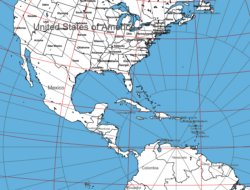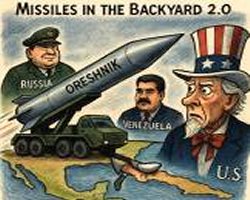Oreshnik Missiles to Venezuela
 In early November 2025, senior Russian officials indicated Moscow's willingness to supply Venezuela with advanced missile systems, including the newly operational Oreshnik hypersonic ballistic missile and Kalibr cruise missiles. This development emerged amid escalating tensions between the United States and Venezuela, with Washington deploying substantial naval forces to the Caribbean region ostensibly for counternarcotics operations. The potential weapons transfer has prompted comparisons to the Cuban Missile Crisis of 1962, though military analysts suggest significant logistical and strategic constraints may limit the scope of any actual deployment.
In early November 2025, senior Russian officials indicated Moscow's willingness to supply Venezuela with advanced missile systems, including the newly operational Oreshnik hypersonic ballistic missile and Kalibr cruise missiles. This development emerged amid escalating tensions between the United States and Venezuela, with Washington deploying substantial naval forces to the Caribbean region ostensibly for counternarcotics operations. The potential weapons transfer has prompted comparisons to the Cuban Missile Crisis of 1962, though military analysts suggest significant logistical and strategic constraints may limit the scope of any actual deployment.
The phrase "Missiles of October" references the Cuban Missile Crisis of October 1962, a 13-day standoff between the United States and the Soviet Union that brought the world to the brink of nuclear war. It began when U.S. intelligence discovered Soviet medium- and intermediate-range ballistic missiles being deployed in Cuba, just 90 miles from Florida. Soviet Premier Nikita Khrushchev had authorized the placement as a response to U.S. Jupiter missiles in Turkey and Italy, as well as perceived threats from American military exercises and the failed Bay of Pigs invasion. President John F. Kennedy imposed a naval blockade (termed a "quarantine") around Cuba to prevent further shipments, leading to tense negotiations.
The crisis ended when the Soviets agreed to remove the missiles in exchange for a U.S. pledge not to invade Cuba and a secret deal to withdraw U.S. missiles from Turkey. It highlighted the dangers of nuclear brinkmanship during the Cold War and led to improved U.S.-Soviet communication, including the establishment of the Moscow-Washington hotline.
The "Missiles of November" is an analogous reference to escalating tensions in Venezuela during November 2025, where Russia had reportedly deployed advanced missiles and military hardware amid fears of U.S. intervention. This situation echoed the 1962 crisis, with Russia positioning weapons in a Latin American ally close to U.S. shores as a counter to perceived American aggression—potentially linked to U.S. support for Ukraine, sanctions on Russia, or threats against Venezuelan President Nicolás Maduro's regime.
Multiple Russian cargo planes, including an Ilyushin Il-76 linked to military operations, had landed in Caracas, delivering heavy cargo such as munitions, missiles (including hypersonic Oreshnik systems), drones, radar components, and air-to-air missiles. Venezuelan officials requested urgent expansions of military cooperation from Russia and China, including radars, missiles, and drones with ranges up to 1,000 km. Russia also pledged to restore Venezuela's Su-30MK2 fighter jets and provide 14 missile defense systems.
Maduro's forces deployed air defenses like the Buk-M2E system, training cadets with FPV drone simulators, and positioning troops on beaches in anticipation of a potential U.S. invasion. Anti-ship missiles like the Bastion system, previously supplied by Russia, are part of Venezuela's coastal defenses.
U.S. warships, including the aircraft carrier USS Gerald R. Ford, have approached Venezuelan waters. Reports indicate the Pentagon is considering air strikes on Venezuelan ports and airports tied to drug trafficking, though incoming U.S. leadership (under President-elect Trump) has verbally ruled out strikes but left operational details vague. Russia stated readiness to assist Venezuela against any U.S. actions, with some Russian lawmakers suggesting arming Venezuela with nuclear-capable missiles as a deterrent.
Commentators describe this as a "Cuban Missile Crisis 2.0" or a "silent riposte" to NATO expansions. Russia's moves, potentially placing hypersonic weapons (capable of evading U.S. defenses) within striking distance of Florida, were seen as a direct response to U.S. plans to deploy long-range Tomahawk cruise missiles in Europe. Unlike 1962, modern hypersonics like Oreshnik and Kalibr add complexity, potentially shortening response times and escalating risks. Venezuela's proximity to the U.S. (closer than Cuba in some aspects) amplifies the stakes, with calls for Maduro to hold new elections amid U.S. pressure.
This situation remains fluid, and underscored ongoing great-power rivalries in the Western Hemisphere.
Russian Statements and Diplomatic Context
 Alexei Zhuravlyov, First Deputy Chairman of the State Duma Defense Committee, told the Russian news outlet Gazeta.ru on November 1, 2025, that Russia sees no obstacles to providing Venezuela with advanced missile systems.[1] Zhuravlyov characterized Russia as one of Venezuela's key military-technical partners, noting that Moscow already supplies Caracas with nearly the complete range of weaponry, from small arms to aviation equipment. He emphasized that details regarding the volume and specific systems being delivered remain classified, suggesting that American military planners might face unexpected developments in the region.
Alexei Zhuravlyov, First Deputy Chairman of the State Duma Defense Committee, told the Russian news outlet Gazeta.ru on November 1, 2025, that Russia sees no obstacles to providing Venezuela with advanced missile systems.[1] Zhuravlyov characterized Russia as one of Venezuela's key military-technical partners, noting that Moscow already supplies Caracas with nearly the complete range of weaponry, from small arms to aviation equipment. He emphasized that details regarding the volume and specific systems being delivered remain classified, suggesting that American military planners might face unexpected developments in the region.
The Russian official's comments appear to have been prompted by a direct appeal from Venezuelan President Nicolás Maduro to Russian President Vladimir Putin, as well as to leaders in China and Iran, requesting military assistance to strengthen Venezuela's defense capabilities.[2] According to reporting based on leaked internal U.S. documents, Maduro specifically requested help with radar systems, aircraft repairs, and possibly missiles to counter the increased American military presence in the Caribbean. The Venezuelan president reportedly characterized Russian-supplied Sukhoi Su-30MK2 fighter aircraft as the most important deterrent available to his government when facing potential military threats.
This diplomatic outreach occurred against the backdrop of a newly ratified strategic partnership treaty between Russia and Venezuela. Putin signed the agreement in October 2025, formalizing cooperation across military, economic, and energy sectors.[3] The treaty appears to provide a legal framework for expanded defense cooperation, including large-scale projects such as a munitions factory that opened in Venezuela's Aragua state in July 2025 after nearly two decades of planning. Additionally, Moscow has secured exploration rights for natural gas and oil deposits valued at billions of dollars, further deepening its economic stake in Venezuela.
United States Military Buildup in the Caribbean
 The Russian statements on potential weapons transfers came in response to a significant American naval deployment to the Caribbean region. The Trump administration dispatched the USS Gerald R. Ford carrier strike group, along with at least eight U.S. Navy warships and a submarine, to waters near Venezuela.[4] By early November 2025, the Ford and its escort, the Arleigh Burke-class guided missile destroyer USS Bainbridge, had passed through the Strait of Gibraltar and were proceeding westward across the Atlantic toward the Caribbean.
The Russian statements on potential weapons transfers came in response to a significant American naval deployment to the Caribbean region. The Trump administration dispatched the USS Gerald R. Ford carrier strike group, along with at least eight U.S. Navy warships and a submarine, to waters near Venezuela.[4] By early November 2025, the Ford and its escort, the Arleigh Burke-class guided missile destroyer USS Bainbridge, had passed through the Strait of Gibraltar and were proceeding westward across the Atlantic toward the Caribbean.
The White House characterized this military buildup as part of counternarcotics operations targeting drug trafficking networks allegedly controlled by the Maduro regime. In August 2025, the U.S. government formally accused Maduro of leading the Cartel de los Soles, a major narcotics-trafficking organization that reportedly collaborates with the Venezuela-based Tren de Aragua gang, Mexico's Sinaloa Cartel, and other international criminal networks. U.S. officials identified specific targets inside Venezuela tied to these drug trafficking operations, though the administration maintained that military action remained unlikely.
President Trump, in an interview with 60 Minutes, downplayed the prospect of armed conflict with Venezuela while criticizing the Maduro government for its role in drug trafficking and migration issues. Secretary of State Marco Rubio similarly suggested that Maduro's tenure as Venezuela's leader might be approaching its conclusion, though both officials emphasized diplomatic and economic pressure rather than military intervention. Despite these assurances, the scale of the U.S. naval presence represents one of the most substantial American military deployments to the Caribbean in recent years.
The Oreshnik Missile System
 The Oreshnik represents Russia's most recent entry into the category of intermediate-range ballistic missiles, though considerable uncertainty surrounds its actual capabilities and operational status. Western and Ukrainian intelligence assessments suggest the system may be derived from or related to the RS-26 Rubezh intercontinental ballistic missile program, with the Oreshnik potentially representing a road-mobile, intermediate-range variant.[5] Russian officials claim the missile can achieve speeds approaching Mach 10 and strike targets at ranges up to approximately 5,500 kilometers, though independent verification of these performance specifications remains limited.
The Oreshnik represents Russia's most recent entry into the category of intermediate-range ballistic missiles, though considerable uncertainty surrounds its actual capabilities and operational status. Western and Ukrainian intelligence assessments suggest the system may be derived from or related to the RS-26 Rubezh intercontinental ballistic missile program, with the Oreshnik potentially representing a road-mobile, intermediate-range variant.[5] Russian officials claim the missile can achieve speeds approaching Mach 10 and strike targets at ranges up to approximately 5,500 kilometers, though independent verification of these performance specifications remains limited.
The missile first came to international attention in November 2024 when Russia conducted what appears to have been a combat test strike against the Ukrainian city of Dnipro. President Putin characterized this attack as retaliation for Ukraine's use of Western-supplied long-range weapons, including American ATACMS missiles and British Storm Shadow cruise missiles, to strike targets inside Russian territory. Following this initial use, Washington classified the Oreshnik as an intermediate-range ballistic missile system, a designation that carries significant implications under international arms control frameworks.
Russian sources describe the Oreshnik as capable of carrying multiple independently targetable reentry vehicles, though the exact payload configuration remains unclear. The system reportedly can be fitted with either conventional or nuclear warheads, giving it potential utility across a range of strategic scenarios. Putin has characterized the missile as a weapon that ensures parity and strategic balance, emphasizing its extended range and hypersonic velocity as key advantages that make interception extremely difficult with current defense technologies.
The production status of the Oreshnik presents a major question mark in any discussion of potential transfers to Venezuela. In August and October 2025, Putin announced that the missile had entered serial production and would be deployed to Russian combat formations, with initial deployment to Belarus also planned.[6] However, the actual number of operational systems remains unknown, and the missile appears to be in very limited supply. Given Russia's ongoing need for precision strike capabilities in Ukraine, where the conflict has consumed substantial quantities of advanced munitions, Moscow may have few Oreshnik missiles available for export even if political will existed to transfer them.
Kalibr Cruise Missile Considerations
 The Kalibr cruise missile family presents a somewhat different calculus than the Oreshnik for potential Venezuelan deployment. Russia has employed Kalibr missiles extensively since the beginning of its full-scale invasion of Ukraine in February 2022, launching these weapons from both surface vessels and submarines against a wide range of targets. The missiles have demonstrated considerable accuracy and have been used to strike both military installations and civilian infrastructure throughout Ukraine, including a particularly deadly attack on the city of Vinnytsia in July 2022 that killed more than 20 civilians.[7]
The Kalibr cruise missile family presents a somewhat different calculus than the Oreshnik for potential Venezuelan deployment. Russia has employed Kalibr missiles extensively since the beginning of its full-scale invasion of Ukraine in February 2022, launching these weapons from both surface vessels and submarines against a wide range of targets. The missiles have demonstrated considerable accuracy and have been used to strike both military installations and civilian infrastructure throughout Ukraine, including a particularly deadly attack on the city of Vinnytsia in July 2022 that killed more than 20 civilians.[7]
Western intelligence assessments suggest Kalibr variants possess ranges between approximately 930 and 1,550 miles, depending on the specific model and payload configuration. From launch positions in Venezuela, these ranges would potentially place portions of the southern United States and numerous facilities throughout the Caribbean within strike range. The containerized Club-K export variant of the Kalibr system presents particular concerns for defense planners, as these launchers can be concealed within standard shipping containers and transported relatively discreetly by sea or air.
The intensive use of Kalibr missiles in Ukraine over nearly four years of sustained combat operations raises questions about Russia's remaining inventory of these systems. International sanctions have affected Russia's ability to produce advanced standoff weapons, as the missiles require sophisticated guidance systems, specialized materials, and precision manufacturing capabilities that may be constrained by export controls on critical components. The rate at which Russian industry can manufacture replacement Kalibr missiles remains uncertain, but military analysts generally assess that these standoff weapons have become considerably more precious to Russian military planners than they were before the Ukraine conflict.
Despite these inventory concerns, Russia has successfully maintained Kalibr production throughout the conflict period, and Zhuravlyov's description of the system as "well-proven" suggests Moscow may view these cruise missiles as more expendable than cutting-edge systems like the Oreshnik. The existence of export variants designed specifically for foreign customers also indicates Russia has historically been more willing to transfer Kalibr technology to allied nations than to share its most advanced strategic systems.
Recent Russian Arms Deliveries to Venezuela
Concurrent with statements about potential future weapons transfers, Russian officials confirmed recent deliveries of air defense systems to Venezuela. Zhuravlyov disclosed that Russian Il-76 transport aircraft had recently delivered Pantsir-S1 and Buk-M2E air defense systems to Caracas.[8] These systems add to Venezuela's existing air defense architecture, which already includes S-300VM (Antey-2500) long-range systems, Buk-M2E medium-range batteries, and Pantsir-S1 short-range point defense units.
The Russian-Venezuelan defense relationship extends back more than two decades, with Venezuela having purchased 24 Su-30MK2 multirole fighter aircraft beginning in 2006. Subsequent deliveries established a layered air defense network anchored by the S-300VM systems, which independent tracking sources indicate arrived around 2012-2013. Buk-M2E deliveries occurred during the 2013-2015 period according to open-source reporting and industry sources. While maintenance of this inventory has been inconsistent over the years, recent Il-76 flights to Caracas suggest renewed Russian attention to sustaining Venezuela's defense capabilities through logistics support and training programs.
This established pattern of military-technical cooperation provides context for Russian claims about potential Oreshnik and Kalibr transfers. Moscow has demonstrated both the political will and logistical capability to deliver sophisticated weapons systems to Venezuela over extended periods, even as the country faced international pressure and economic sanctions. The question is not whether Russia could theoretically deliver advanced missiles to Venezuela, but rather whether such transfers align with Russian strategic interests and whether Moscow possesses sufficient quantities of these weapons to spare for export.
Legal and Arms Control Implications
Any transfer of Oreshnik missiles to Venezuela would raise significant questions under international arms control frameworks, particularly the Missile Technology Control Regime. The MTCR represents an informal arrangement among partner nations to restrict exports of missile systems capable of delivering at least a 500-kilogram payload to ranges of at least 300 kilometers.[9] The Oreshnik clearly exceeds these thresholds by substantial margins, falling squarely into Category I restrictions that call for the strongest presumption of denial for export applications.
Russia participates in the MTCR as a partner nation, though the regime functions through voluntary adherence rather than binding treaty obligations. Moscow has previously demonstrated willingness to interpret MTCR guidelines flexibly when such interpretations serve Russian strategic interests, and Russian officials have consistently maintained that sovereign nations retain the ultimate authority to make their own export decisions. In the context of Venezuela, Russia would likely argue that any weapons transfers represent legitimate defense cooperation between sovereign states responding to perceived American aggression in the region.
For long-range variants of the Kalibr cruise missile, the legal situation becomes more ambiguous. While some Kalibr models would clearly trigger MTCR restrictions, Russia has developed export variants with deliberately limited ranges designed to remain below Category I thresholds. Moscow could potentially argue that transfer of these constrained-range versions respects the letter of MTCR commitments while still providing Venezuela with meaningful standoff strike capabilities. Such arguments would likely prove unconvincing to the United States and other Western nations, but they would provide Russia with a diplomatic position from which to defend the transfers.
Beyond the MTCR, broader questions of regional stability and the potential for arms racing in Latin America arise from any significant Russian weapons transfers to Venezuela. The deployment of advanced ballistic missiles to the Western Hemisphere would represent a substantial shift in the regional security environment, potentially prompting responses from the United States and other nations concerned about the implications for their own security. The historical precedent of the Cuban Missile Crisis demonstrates how sensitive Washington remains to the presence of Soviet or Russian strategic weapons in the Caribbean basin.
Logistical Challenges and Technical Feasibility
Military analysts have identified substantial logistical obstacles to any significant deployment of Oreshnik systems to Venezuela. The combined weight of an Oreshnik missile and its mobile launcher is estimated at approximately 70 tons, requiring heavy-lift transport aircraft for intercontinental movement.[10] Russia's Antonov An-124 Ruslan cargo aircraft represent the most capable platform for such missions, but these aircraft operate in limited numbers and face significant demands supporting Russian military operations across multiple theaters.
A minimal deployment of even a single Oreshnik system with supporting equipment would require multiple An-124 flights carrying the missile, launcher, command and control equipment, maintenance facilities, and spare parts. A more operationally meaningful deployment of several launchers with adequate missile stocks would demand a sustained airlift effort that would almost certainly be detected by American and allied intelligence assets monitoring transatlantic air traffic. Satellite imagery, signals intelligence, and human intelligence sources would likely provide advance warning of such movements, allowing the United States to respond diplomatically or militarily before systems became operational.
For Kalibr missiles, particularly containerized variants, the logistical picture differs considerably. Club-K systems designed for export can be transported by conventional cargo aircraft or aboard surface vessels, making discrete deployment more feasible. Russia has demonstrated the ability to move weapons systems to Venezuela by sea, with cargo vessels making regular runs between Russian ports and Venezuelan harbors. The containerized nature of some Kalibr variants would allow them to blend with legitimate commercial cargo, though intelligence agencies would likely maintain close surveillance of suspicious shipments.
The technical infrastructure required to operate these systems in Venezuela presents additional challenges. Ballistic missiles like the Oreshnik demand sophisticated support facilities, including specialized maintenance capabilities, secure storage for missiles and warheads, trained personnel for operations and maintenance, and command and control networks integrated with national leadership. While Venezuela has developed some indigenous defense industrial capabilities with Russian assistance, including the recently opened munitions factory, the technological sophistication required for Oreshnik operations may exceed current Venezuelan capabilities without substantial Russian technical assistance.
Strategic Implications and American Responses
The potential deployment of Russian missiles to Venezuela carries significant strategic implications for American defense planning and regional security architecture. From launch positions in Venezuela, Oreshnik missiles with reported ranges up to 5,500 kilometers could theoretically reach targets throughout the continental United States, though the southern states and Caribbean facilities would be most immediately threatened. This geographical reality echoes the strategic calculus that drove American responses during the Cuban Missile Crisis, when Soviet ballistic missiles positioned just 90 miles from Florida fundamentally altered the strategic balance.
Defense planners would need to consider how to counter these systems through a combination of offensive and defensive measures. The hypersonic speed and maneuverability claimed for the Oreshnik would present significant challenges for existing American missile defense systems, which are optimized primarily to intercept slower, more predictable ballistic missile trajectories. Successfully defending against multiple Oreshnik missiles simultaneously might require deployment of additional Terminal High Altitude Area Defense batteries or other advanced interceptor systems to the threatened regions.
Offensive counter-options would center on the ability to locate and destroy missile launchers before they could fire. The Oreshnik's reported road-mobile configuration would allow Venezuelan forces to disperse launchers across the country, complicating American targeting efforts. Any campaign to neutralize these systems would require persistent surveillance coverage, rapid strike capabilities, and potentially extensive operations inside Venezuelan territory. Such military operations could quickly escalate beyond limited strikes into broader conflict, raising the stakes considerably for both sides.
For Kalibr cruise missiles, American defense responses would focus on different capabilities. The subsonic flight profiles of most cruise missile variants make them more vulnerable to interception than hypersonic ballistic missiles, but defending against saturation attacks involving multiple simultaneous Kalibr launches would strain available defenses. Coastal installations and naval assets would require robust short-range air defense systems, while early warning coverage would need enhancement to provide adequate reaction time against cruise missile threats launched from Venezuelan territory.
Kremlin Signaling and Strategic Messaging
Russian statements regarding potential weapons transfers to Venezuela should be understood partly as strategic messaging directed at the United States rather than purely operational planning. Moscow has historically used threats of weapons transfers to American adversaries as bargaining chips in broader negotiations over security arrangements, arms control agreements, and regional influence. President Putin explicitly threatened to provide standoff weapons to American enemies in previous statements, framing such transfers as responses to Western military assistance to Ukraine.
The timing of Zhuravlyov's comments, coinciding with the American naval buildup in the Caribbean, suggests Russia seeks to impose potential costs on U.S. actions in Latin America and demonstrate that Moscow retains options for responding asymmetrically to American pressure. By raising the specter of advanced missiles in Venezuela, Russia may aim to complicate American military planning, generate domestic political debate about the wisdom of confronting the Maduro regime, and signal to other nations that Russia remains willing and able to support allies facing American pressure.
However, the gap between rhetorical threats and actual weapons transfers can be substantial. Russia has made similar threats regarding other nations and weapons systems over the years without always following through on deployment. The practical constraints discussed earlier regarding missile inventories, logistical challenges, and potential American responses all factor into Russian decision-making beyond the public statements of individual officials. Zhuravlyov, while a senior legislator, does not necessarily speak for Putin or the Russian military leadership when discussing potential arms transfers.
Venezuelan Perspectives and Strategic Calculations
 For Venezuela, the potential acquisition of advanced Russian missile systems would represent both a significant defensive enhancement and a major strategic gamble. The Maduro government faces genuine security concerns stemming from American military presence in the region, ongoing economic sanctions, diplomatic isolation, and internal political opposition. Advanced air defense systems and standoff strike capabilities could theoretically provide some deterrent value against potential American military action or coercive pressure.
For Venezuela, the potential acquisition of advanced Russian missile systems would represent both a significant defensive enhancement and a major strategic gamble. The Maduro government faces genuine security concerns stemming from American military presence in the region, ongoing economic sanctions, diplomatic isolation, and internal political opposition. Advanced air defense systems and standoff strike capabilities could theoretically provide some deterrent value against potential American military action or coercive pressure.
However, accepting deployment of Russian missiles, particularly nuclear-capable systems like the Oreshnik, would elevate Venezuela to the status of a potential nuclear flashpoint in American strategic planning. This designation would likely trigger intensified American pressure through sanctions, diplomatic isolation, and potentially direct military action to prevent or eliminate missile deployments. The historical precedent of American responses to Soviet missile deployments in Cuba demonstrates Washington's willingness to risk major conflict to prevent hostile strategic weapons from being positioned in the Western Hemisphere.
Venezuelan military capabilities to effectively operate and maintain advanced Russian missile systems also remain questionable. The country has struggled to maintain its existing Russian-supplied military equipment, with reports indicating that many Su-30 fighters and air defense systems require repairs and upgrades. Adding complex new systems would further strain limited technical expertise and resources. The degree to which Russian personnel would need to remain in Venezuela to support operations could effectively turn missile deployments into a permanent Russian military presence, raising additional sovereignty concerns.
Regional Security Environment and Broader Context
 The potential for Russian missile deployments to Venezuela unfolds against a backdrop of evolving great power competition extending into Latin America. China has substantially increased its economic presence throughout the region over the past two decades, while Russia has sought to maintain political and military relationships with governments ideologically opposed to American influence. Venezuela's alignment with Russia reflects both ideological affinity and practical need for external support in the face of American pressure and economic collapse.
The potential for Russian missile deployments to Venezuela unfolds against a backdrop of evolving great power competition extending into Latin America. China has substantially increased its economic presence throughout the region over the past two decades, while Russia has sought to maintain political and military relationships with governments ideologically opposed to American influence. Venezuela's alignment with Russia reflects both ideological affinity and practical need for external support in the face of American pressure and economic collapse.
Other Latin American nations would need to calculate their responses to Russian missiles in Venezuela carefully. While some governments maintain relatively friendly relations with Caracas, few would welcome the militarization of the Caribbean basin or the potential for their region to become contested terrain in great power rivalry. Brazil, Colombia, and other neighbors might face pressure from both Washington and Moscow to take positions on Venezuelan missile deployments, complicating their efforts to maintain independence in foreign policy.
The Organization of American States and other regional institutions would likely become forums for diplomatic efforts to address any missile deployments. However, these organizations have proven largely ineffective in constraining Venezuelan government actions in recent years, with Caracas dismissing their criticisms and proceeding with policies regardless of regional opposition. The limited leverage available to hemispheric institutions suggests that any resolution of a missile crisis would ultimately require direct engagement between Washington and Moscow rather than regional mediation.
Assessment and Outlook
 The probability of actual Oreshnik deployment to Venezuela appears limited based on current evidence, though Kalibr transfers may present a more realistic near-term possibility. The substantial logistical challenges, limited Russian missile inventories, potential for American interdiction or preemptive action, and uncertain operational benefits all argue against large-scale Oreshnik deployment in the immediate future. Russian statements appear calculated more for strategic signaling than as concrete operational planning, though this assessment could change rapidly if circumstances evolve.
The probability of actual Oreshnik deployment to Venezuela appears limited based on current evidence, though Kalibr transfers may present a more realistic near-term possibility. The substantial logistical challenges, limited Russian missile inventories, potential for American interdiction or preemptive action, and uncertain operational benefits all argue against large-scale Oreshnik deployment in the immediate future. Russian statements appear calculated more for strategic signaling than as concrete operational planning, though this assessment could change rapidly if circumstances evolve.
More limited transfers remain plausible, potentially including additional air defense systems, containerized Kalibr cruise missiles, or technical assistance for existing Venezuelan military equipment. These lower-profile deliveries would enhance Venezuelan defensive capabilities without crossing the threshold that might trigger decisive American responses. Russia has demonstrated both capability and willingness to provide such support over many years, and the newly ratified strategic partnership treaty provides legal framework for expanded cooperation.
The situation bears continued monitoring, particularly for concrete indicators such as An-124 cargo flights to Venezuela, satellite imagery of new military installations suitable for ballistic missile deployment, or shifts in Russian public statements from possibility to commitment. The absence of such indicators would suggest that Russian statements represent strategic messaging rather than imminent operational deployments. Conversely, the appearance of these warning signs could indicate Moscow's serious intent to alter the strategic balance in the Western Hemisphere, potentially precipitating a major international crisis.
For American policy makers, the challenge lies in responding appropriately to Russian threats without overreacting to what may prove largely rhetorical posturing. Excessive military buildup in response to threats alone could prove counterproductive, straining resources and potentially driving Russia and Venezuela toward actions they might otherwise avoid. Conversely, dismissing Russian statements entirely could result in strategic surprise if Moscow proceeds with transfers. Calibrating responses to match actual rather than threatened developments while maintaining robust intelligence collection represents the essential task for managing this evolving situation.
|
NEWSLETTER
|
| Join the GlobalSecurity.org mailing list |
|
|
|

